A New Era of Cancer Screening is here!
- Carrie Ballas

- Mar 31, 2022
- 7 min read
Updated: Jan 6
Statistics
Cancer is the second-leading causes of death in the world.
An estimated 19.3 million new cancer cases and 10 million cancer deaths occurred worldwide in 2020.
By 2040, the number of new cancer cases per year globally is expected to rise to 27.5 million and the number of cancer-related deaths to 16.3 million.
An estimated 1,900,000 new cases of cancer were diagnosed and 608,570 cancer deaths occurred in the U.S. in 2021.
It is estimated that 41 out of 100 men and 39 out of 100 women will develop cancer in their lifetime.
The National Cancer Institute estimates that cancer-related direct medical costs in the U.S. were $183 billion in 2015 and are projected to increase to $246 billion by 2030.
80% of all cancers in the U.S. are diagnosed in people 55 years of age or older
Cancer is a group of diseases characterized by the uncontrolled growth and spread of abnormal cells that can result in death if not treated. Although we all have the potential to grow cancer cells, we know that certain risk factors to developing cancer does exist. These risk factors include; genetic mutations, viruses and infections, UV damage, environmental toxins, diets low in fruits and vegetables, stress, trauma, tobacco smoking, alcohol, lack of exercise, obesity and more.
Every one of us has been impacted by cancer one way or another. On a personal note, I lost my father in 2010 to lung cancer (he was not a smoker), who randomly found out he had cancer after getting a chest X-ray due to a viral cold. More recently, a close friend found out she has liver cancer, and the only reason she found out was because of a Magnetic Resonance Imaging (MRI) from a bike accident.
What if we could have a preventative screen for cancer where we could catch cancer before it was too late? Lucky for us, there is a new cancer screen that is doing just that!
I would like to introduce you to the new revolutionary cancer screen called the Galleri Multi-Cancer Early-Detection Test (by GRAIL)
The cutting-edge technology that Grail is using allows for the EARLY detection of up to fifty different types of cancer, many of which are not commonly screened for today, through a simple blood draw AND before the cancer would otherwise be found.
Think of this, if cancer is caught in its early stages, the treatment outcomes and survival rates would be significantly improved. The lifesaving and cost saving benefits of an early detection cancer screen are immense, not to mention reducing the collective sadness and loss that we all experience when someone is diagnosed with cancer.
Screening tests like The Galleri could be the “Holy Grail” of the cancer screening world.
As you all know, one of my key missions in being a health care provider is to promote wellness and be on the leading edge of preventive healthcare. I am always looking for the best way to help my patients prevent illness, disease and live the best and healthiest lives possible. I am thrilled to see how this test will impact my patient’s lives and their families’ lives for the better!
Current screening and guidelines
Currently there are only a few cancer screening tools that are recommended to the general population and covered as “preventative” by insurances. These screening tools include; colorectal cancers (starts at age 45 now), cervical cancer (starts age 25), breast screening with Mammograms (starts age 45). There are other cancers that are advisable to monitor and discuss with your primary care provider, which are; prostate, lung, endometrial and skin cancer. With over 200 cancers being identified, you can tell that many cancers are missed with these current screening guidelines. Luckily cancer deaths have declined by 3.2 million from 1991 to 2018 due to these basic approved screening tools, however there are still limitations with access pr using these tools for many populations, especially related to insurance and health care access.
Cancer at any stage
We know that we are more likely to survive cancer if we find it at an earlier stage. Screening guidelines to find cancer at an early stage, before symptoms have started, are limited and therefore, most types of cancer are detected only when symptoms present themselves (or one finds them on a random X-ray or MRI if you are lucky), when survival rates are much lower. Those people with late diagnosis and more advanced disease are more difficult to diagnose, treat and therefore have much worse outcomes. In fact, when cancers are diagnosed early before they have had the chance to spread, the overall 5-year survival rate is 4x higher than when diagnosed in later stages.
Galleri is changing this paradigm!
GRAIL’s first-to-market cancer detection panel is being offered through private medical clinics, particularly functional medicine clinics where prevention is a priority, and is now a cancer screening option we clinicians can offer this directly to our patients.
How accurate is the Galleri Test?
Galleri detects about 50% of all 50 cancers they screen.
Galleri has a higher sensitivity for detecting more aggressive cancers, up to 67.6% in detection. They have 12 cancers they label as “aggressive cancers” which include: Anus, Bladder, Colon/Rectum, Esophagus, Head & Neck, Liver/Bile Duct, Lung, Lymphoma, Ovary, Pancreas, Plasma Cell Neoplasm & Stomach.
Please check out this link for a list of the 50 Cancers screened.
How much does it cost?
At this time it is a cash-only test ($949) and many people are using their HSA for payment (which is about 6 dinners out in Boulder for perspective). GRAIL is working with the Center for Medicare and Medicaid, and with insurance companies to try to get this covered, but that is a future hope. Our office will get no remuneration or payments for the Galleri Test or for any referral. It takes approximately 2 weeks for your report and we will schedule a review session in-person or via teleconference when results are received.
Who is a candidate?
The Galleri screening test is for adults aged 50 or older or for younger individuals with a higher-than-usual risk of cancer.
Patients with existing cancers or cancer survival/cure < 3 years should NOT have the Galleri Test.
The Galleri Test is not perfect or foolproof; but does offer a new science and technology. The Galleri Test is not designed to replace or delay the tests that are already done routinely and per Guidelines. In fact, a {+} test might mean a patient needs their routine test done earlier than planned. So, even with the Galleri Test, patients still need to do their normal and recommended cancer screening.
How does it work?
We will send you with a requisition and test kit to get your blood drawn. Once the blood sample is sent in to GRAIL, the Galleri test will look for the genetic changes that happen to the DNA when a normal cell turns to cancer. When a cancer cell finishes its lifespan, it releases this abnormal DNA into the blood stream. “Cell-free DNA” is then isolated by the Galleri test for identification. Galleri detects the actual presence of cancer; not simply the risk for cancer as is included in other genomic tests we have offered.
There are two possible results from the tests:
Cancer signal not detected.This means that no cancer signal was found; however, not all cancers can be detected by the Galleri test. This is very reassuring, however, it is important to continue with routine recommended cancer screening tests, such as mammograms/ultrasounds and colonoscopies.
Cancer signal detected.This means that there is a high suspicion of cancer even at a very early stage.The tests are highly specific, which means that there is less than a 1% chance of a false-positive, which is very important. The scientists who developed Galleri were insistent upon avoiding unnecessary follow-up testing and unnecessary anxiety and worry due to a false-positive result.
If a cancer signal is found, the results can point to where in the body the cancer is coming from with high accuracy (because each cancer has it’s own methylation cycle, which this test can identify specifically) and therefore it will allow us to plan specific follow-up testing, such as scans, biopsies and procedures to further explore the cancer. For example, a signal for lung cancer can be followed by a CT scan of your lungs or a signal for colon cancer indicates the need for a colonoscopy, even if you’re not officially due for one. This makes the test actionable and answers the question “what can be done if cancer is suspected.”
It remains unclear how the insurance industry will receive this enhanced capability for detection. Will insurance cover the necessary imaging studies due to a positive Galleri test result? It’s so early that we don’t know that answer yet, but I will work with you on getting the subsequent workup as economically as possible.
How does this benefit me as a healthy patient?
The Galleri test:
Detects many cancers that are not commonly screened for today, so you can find out you have cancer before symptoms occur and get treated earlier.
Can be incorporated into a routine visit through a simple blood draw.
Finds cancer signals in the blood and can point to where in the body the cancer is coming from, which helps guide us practitioners to your next steps.
You may have been reading or hearing about this exciting test already, as it has been in the news, but if not, please click on these links to find out more.
You can also learn more about the test by watching: short explainer video
Please visit Galleri to review frequently asked questions and view the brief animated video: What is the Galleri Test?
I hope you share my enthusiasm for this unique and innovative screening test for cancer. It promises to offer innovative, safe, and effective technology that can transform cancer screening and cancer care.
As always, I will be available to answer any questions or requests for this test in an appointment. I am committed to continuing my search for the best options to keep you alive, healthy and thriving!
Yours in health and wellness!
Carrie Ballas










